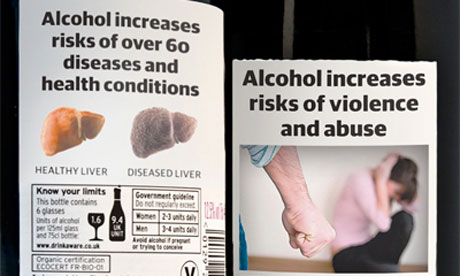
The UK government has considered graphic alcohol warning labels to combat “widespread public ignorance” on its harms.
Last week, I posted a letter to the editor of mine that had appeared in the National Post, in the midst of a discussion of the tragic rape-driven deaths of teenagers Rehtaeh Parsons in Nova Scotia and Audrie Pott in California. In both cases, the perpetrators and victims were said to be intoxicated. As I suggested in my letter, perhaps some of the blame ought to fall to all of us, who do little to curb the use of alcohol.
Somehow it didn’t surprise us when it turned out that these rapes of fifteen year-olds had happened under the influence of alcohol. In fact, 40% of violent crimes in the US are alcohol related, according to the US Department of Justice. Alcohol kills around 100,000 people in the US every year, and around 2,500,000 globally. And only a small proportion of these deaths (around 13.5%) are drunk driving deaths–the majority of alcohol deaths come from liver damage, strokes, overdose, murders, suicides, and accidents spurred by intoxication. In addition to causing death, alcohol consumption can weaken families through addiction and physical abuse, become a replacement for healthy social entertainment and reduce workplace productivity. No wonder a study published in an established medical journal labelled alcohol the fourth most harmful drug to the user, ahead of tobacco, and the most harmful drug to others, making it the most harmful drug overall:

Alcohol is the most harmful drug in the UK, according to the Lancet.
I don’t want to paint too bleak a picture. Drug use has fallen in our society over the last few decades. After being awakened to the severe long-term health effects of tobacco and detrimental effects of secondhand smoke, especially on children, we’ve taken a number of bold steps to curb tobacco use. Federal and regional governments have banned most forms of tobacco advertising, mandated large warning labels on packaging, and undertaken major public health campaigns to educate people about the dangers of tobacco. Today tobacco is stigmatized, use has plummeted, and few children are raised with the assumption that cigarette use is simply a lifestyle choice. In elementary school, I was taught that if you smoked, you’d get lung cancer. Adults were very direct in telling us not to smoke. Very few people in my peer group even considered doing something so unwise.
However, we’ve all been cowards when it comes to combating alcohol, despite the fact that the social costs of alcohol fall on everyone, users and non-users alike. While certain alcohol related behaviors are stigmatized, including drunk driving and drinking while pregnant, liberal alcohol use is accepted by just about everyone. By their mid-teens, when most young people start drinking alcohol, teenagers have been exposed to casual alcohol use by their parents and other trusted adults, as well as to thousands of beer and liquor advertisements. And while most teens are likely aware of the dangers of impaired driving, they’ve probably been taught very little about alcoholism, liver damage, impaired judgment, alcohol-induced rape and violence, stroke and heart disease. How can anyone use a drug responsibly without a thorough education in its dangers?
I’ll admit my bias: as a Mormon, I don’t use alcohol, and I find it hard to sympathize with the culture surrounding it. But I’m not a radical. I emphatically do not promote the prohibition of alcohol. History teaches us that banning alcohol causes more harm than good. What I do promote are some of the same measures that have been taken to reduce tobacco use: graphic warnings on labels, severe restrictions on alcohol advertising and public health campaigns to educate everyone, especially young people, about the dangers of alcohol. These measures wouldn’t diminish the ability of responsible alcohol drinkers to purchase and use alcohol legally, but the demand for the drug would certainly fall, as would the number of crimes and deaths to which it contributes. We could expect that the alcohol industry would fight these measures, just as the tobacco industry fought similar measures in decades past.
The most realistic first step is probably mandating warnings on alcohol labels. The US federal government and a few Canadian jurisdictions already require small warnings on labels. These warnings are good, but they’re not very direct, and they’re small enough to ignore, unlike tobacco warnings. In 2005, Parliament considered a bill to require warnings across Canada, but the government fell before the bill could be taken to a vote. If you feel the same way I do, consider sending a letter to the federal Health Minister if you live in Canada, or to the FDA, Department of Health and Human Services, or your congressional representative in the US, and encourage them to promote warning labels on alcohol.



















